The battle
The combat took place in the Camino Real sector, near the small town of Bilován, south of the city of Guaranda. The Guayaquil troops advanced towards the northwest, in an attempt to reach Quito. However, the Royalists had fortified themselves in Camino Real with the aim of stopping the Patriots and after this, organize an attack on the city of Guayaquil itself, and thus end the rebellion within the Royal Audiencia of Quito.
The Guayaquil forces, or the so-called División Protectora de Quito, were commanded by Colonels Luis Urdaneta and León de Febres-Cordero, while the Royalists was led by Colonel Antonio Fominaya. The Royalists had prepared several ambushes, however, the pro-independence troops were alerted to Fominaya's movements, after which they conceived and developed a strategy that allowed them to win the battle and, subsequently, make the Royalists retreat towards the north.

Antonio José de Sucre y Alcalá, known as the "Gran Mariscal de Ayacucho", was a Venezuelan general and politician who served as the president of Bolivia from 1825 to 1828. A close friend and associate of Simón Bolívar, he was one of the primary leaders of South America's struggle for independence from the Spanish Empire.
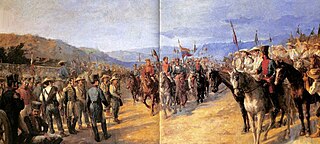
Bolívar's campaign to liberate New Granada also known as the Liberation Campaign of 1819 was part of the Colombian and Venezuelan wars of independence and was one of the many military campaigns fought by Simón Bolívar. In 1819 Bolívar led a combined New Granadan and Venezuelan Army in a campaign to liberate New Granada which had been under Spanish control since 1816.

The Battle of Boyacá (1819), also known as the Battle of Boyacá Bridge was a decisive victory by a combined army of Venezuelan and New Granadan troops along with a British Legion led by General Simon Bolivar over the III Division of the Spanish Expeditionary Army of Costa Firme commanded by Spanish Colonel José Barreiro. This victory ensured the success of Bolívar's campaign to liberate New Granada. The battle of Boyaca is considered the beginning of the independence of the north of South America, and is considered important because it led to the victories of the battle of Carabobo in Venezuela, Pichincha in Ecuador, and Junín and Ayacucho in Peru. New Granada acquired its definitive independence from the Spanish Monarchy, although fighting with royalist forces would continue for years.

The Battle of Pichincha took place on 24 May 1822, on the slopes of the Pichincha volcano, 3,500 meters above sea-level, right next to the city of Quito, in modern Ecuador.
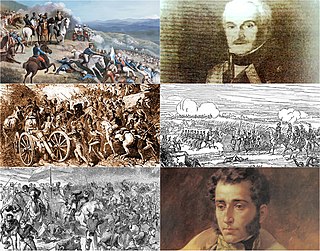
The Ecuadorian War of Independence, part of the Spanish American wars of independence of the early 19th century, was fought from 1809 to 1822 between Spain and several South American armies over control of the Real Audiencia of Quito, a Spanish colonial jurisdiction which later became the modern Republic of Ecuador. The war ended with the defeat of the Spanish forces at the Battle of Pichincha on May 24, 1822, which brought about the independence of all the lands of the Real Audiencia of Quito.

José María Córdova Muñoz, also known as "Hero of Ayacucho", was a General of the Colombian army during the Independence War of Colombia, Perú, and Bolivia from Spain.
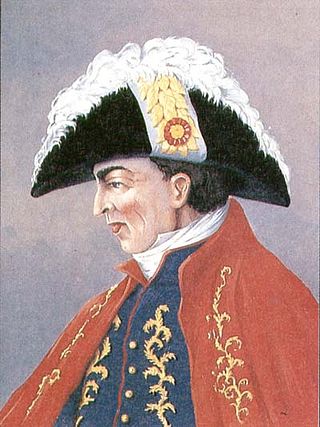
Juan José Francisco de Sámano y Uribarri de Rebollar y Mazorra, was a Spanish military officer and the last viceroy of New Granada from March 9, 1818 to August 9, 1819, during the Colombian War of Independence.

The Protectorate of Peru, also known as the Protectorate of San Martín, was a protectorate created in 1821 in present-day Peru after its declaration of independence from the Spanish Empire. The protectorate existed for one year and 17 days under the rule of José de San Martín and Argentina.

The Free Province of Guayaquil was a South American state that emerged between 1820 and 1822 with the independence of the province of Guayaquil from the Spanish monarchy. The free province had a provisional government and constitution until its annexation by Gran Colombia in 1822. Its successor was the Department of Guayaquil forming part of Gran Colombia.
The Spanish province of Guayaquil had been separated from the Viceroyalty of Peru and in those days it only depended legally on the court of the Real Audiencia de Quito. About a decade later, the Departments of Guayaquil, Azuay, and Ecuador separated from Gran Colombia forming the current Ecuador.

The 1827 Guayaquil uprising, also known as the Guayaquil Department rebellion, was a rejection of the centralist policies of Gran Colombia. This was one of the first separatist rebellions in the country of Gran Colombia before it dissolved in 1829.

The October 9 Revolution was a successful revolt against the Spanish Empire in Guayaquil on October 9, 1820. It was led by the General Antonio José de Sucre and directed by Simón Bolívar. The revolt established a revolutionary junta and created the Free Province of Guayaquil, an independent state. The independence of Guayaquil revived the war of independence of the Real Audiencia de Quito as part of the Spanish American wars of independence. Prominent events in the revolution include the uprising of the Spanish garrison in the city of Guayaquil and the control of the Pacific by the Liberating Expedition of Peru, under the command of José de San Martín.
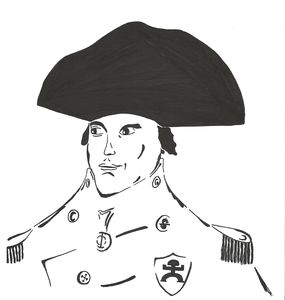
Antonio Fominoya was a Spanish soldier who served as the governor of Socorro and fought in the Ecuadorian War of Independence and in the Spanish reconquest of New Granada.
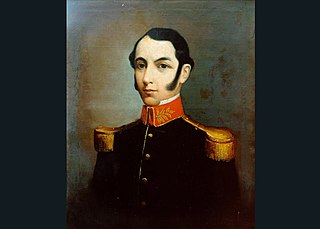
Luis Urdaneta Farías was a Venezuelan soldier and revolutionary who participated in several military campaigns of the Spanish American Wars of Independence. Initially part of the troops loyal to the Spanish Empire, he switched sides during the conflict. He participated and played a leading role in the independence of Guayaquil. He fought in several battles under the command of Marshal Antonio José de Sucre in the Southern Campaign and in the Gran Colombia–Peru War. He insurrectioned against Juan José Flores' attempted separation of the Southern District from Gran Colombia.
The Quito Revolution (1809–1812) was a series of events that took place between 1809 and 1812 in the Real Audiencia de Quito, which led to the establishment of a short-lived State of Quito, and which can be considered as the seed of the independence movements that ended up forming the current Republic of Ecuador.
The First Battle of Huachi was the second battle in the Ecuadorian War of Independence, that took place on 22 November 1820 near Ambato, Ecuador. The battle was fought between Royalist soldiers in support of the Spanish Empire, and the Patriot forces of the Free Province of Guayaquil, who suffered a serious defeat.

The Battle of Yaguachi or Battle of Cone was a military confrontation that occurred on 19 August 1821 between Guayaquil independence troops and Grancolombian reinforcements, led by Antonio José de Sucre, against Royalist troops led by Colonel Francisco González. The battle was fought near the city of Yaguachi, current Province of Guayas in Ecuador, and was a victory for the Patriots which ensured the definitive independence of the Free Province of Guayaquil.

The Second Battle of Huachi was a confrontation that occurred on 12 September 1821 between pro-independence troops led by General Antonio José de Sucre and Royalist troops led by General Melchor Aymerich, president of the Real Audiencia of Quito. Sucre, after having won the Battle of Yaguachi on 19 August, advanced towards Quito. The Spanish, who followed closely, positioned themselves to do battle in a field called Huachi, where they had already defeated Guayaquil forces a year before.

The Pasto Campaign was a series of military operations carried out between 1822 and 1824 by Gran Colombia against the Royalist strongholds of San Juan de Pasto and Patía, Cauca in present-day Southern Colombia.
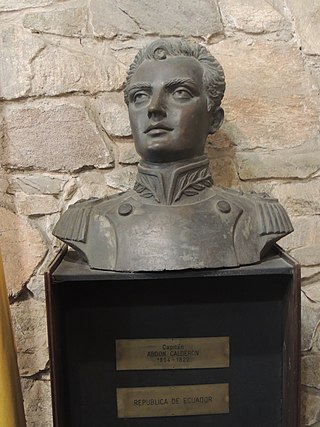
Abdón Calderón Garaycoa was a hero of Ecuador's war of independence. He died at age 17 from wounds sustained at the Battle of Pichincha. Such was his heroism that Simón Bolívar not only promoted him post-mortem but also decreed that in the future the first company of the Yaguachi battalion be reviewed as if he were alive, an honor rarely seen in military history.

Campaigns of the South is the name given to a series of military campaigns that Greater Colombia launched between 1820 and 1826 in South America with the purpose of expanding over the territories of the current republics of Colombia and Ecuador, as well as consolidating the independence of the republics of Peru and Bolivia. This was an extension of the multifaceted civil war launched against the Royalist Army in the Americas, which sustained the integrity of the Spanish Empire in such territories. Beyond the surrender of the regular armies, the royalist guerrillas in each country fought for several more years.


















